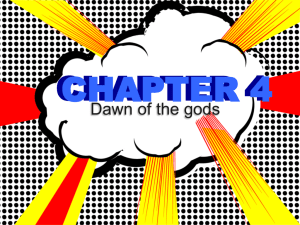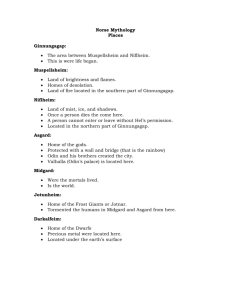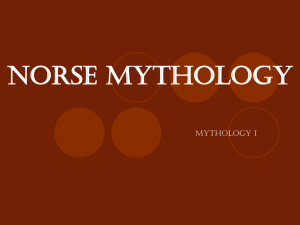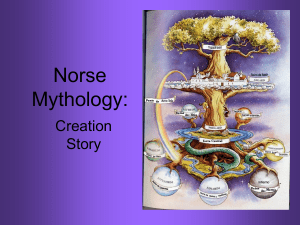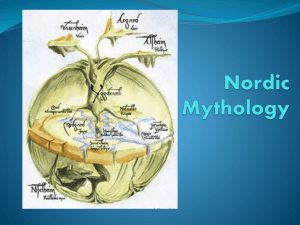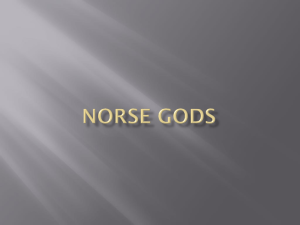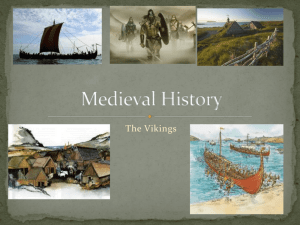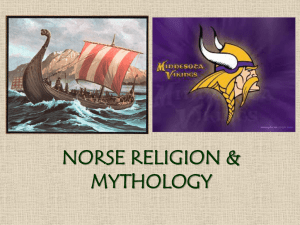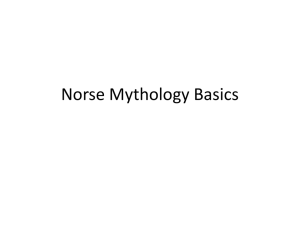Name: An Introduction to Norse Mythology Origins: Norse mythology
advertisement
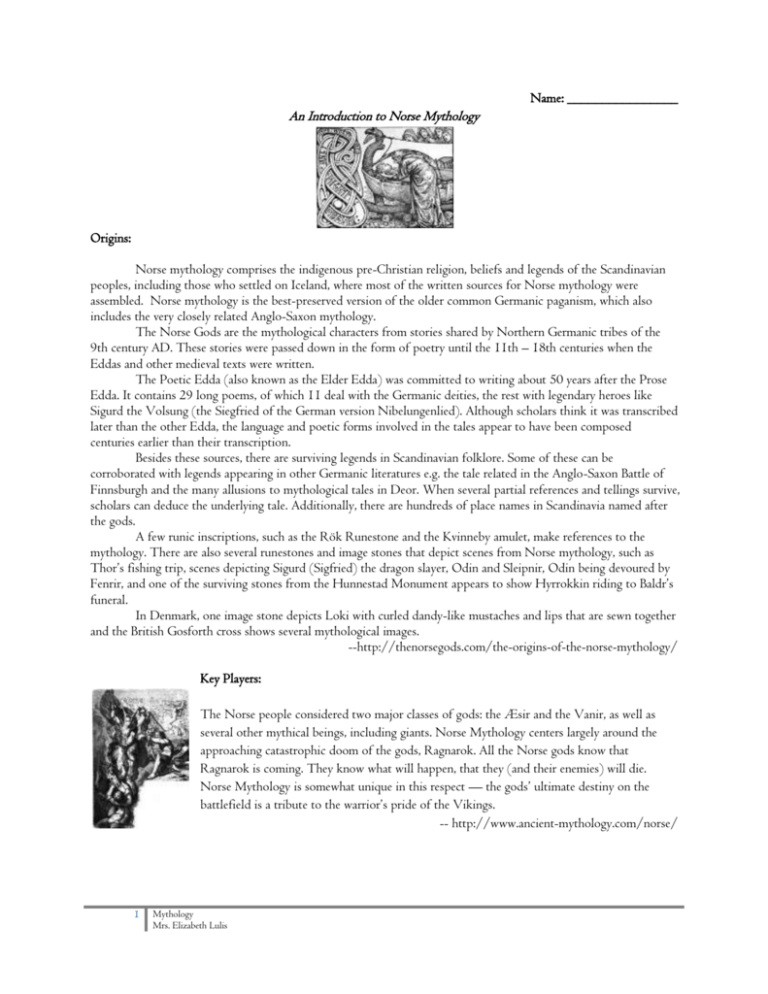
Name: ________________ An Introduction to Norse Mythology Origins: Norse mythology comprises the indigenous pre-Christian religion, beliefs and legends of the Scandinavian peoples, including those who settled on Iceland, where most of the written sources for Norse mythology were assembled. Norse mythology is the best-preserved version of the older common Germanic paganism, which also includes the very closely related Anglo-Saxon mythology. The Norse Gods are the mythological characters from stories shared by Northern Germanic tribes of the 9th century AD. These stories were passed down in the form of poetry until the 11th – 18th centuries when the Eddas and other medieval texts were written. The Poetic Edda (also known as the Elder Edda) was committed to writing about 50 years after the Prose Edda. It contains 29 long poems, of which 11 deal with the Germanic deities, the rest with legendary heroes like Sigurd the Volsung (the Siegfried of the German version Nibelungenlied). Although scholars think it was transcribed later than the other Edda, the language and poetic forms involved in the tales appear to have been composed centuries earlier than their transcription. Besides these sources, there are surviving legends in Scandinavian folklore. Some of these can be corroborated with legends appearing in other Germanic literatures e.g. the tale related in the Anglo-Saxon Battle of Finnsburgh and the many allusions to mythological tales in Deor. When several partial references and tellings survive, scholars can deduce the underlying tale. Additionally, there are hundreds of place names in Scandinavia named after the gods. A few runic inscriptions, such as the Rök Runestone and the Kvinneby amulet, make references to the mythology. There are also several runestones and image stones that depict scenes from Norse mythology, such as Thor’s fishing trip, scenes depicting Sigurd (Sigfried) the dragon slayer, Odin and Sleipnir, Odin being devoured by Fenrir, and one of the surviving stones from the Hunnestad Monument appears to show Hyrrokkin riding to Baldr’s funeral. In Denmark, one image stone depicts Loki with curled dandy-like mustaches and lips that are sewn together and the British Gosforth cross shows several mythological images. --http://thenorsegods.com/the-origins-of-the-norse-mythology/ Key Players: The Norse people considered two major classes of gods: the Æsir and the Vanir, as well as several other mythical beings, including giants. Norse Mythology centers largely around the approaching catastrophic doom of the gods, Ragnarok. All the Norse gods know that Ragnarok is coming. They know what will happen, that they (and their enemies) will die. Norse Mythology is somewhat unique in this respect — the gods’ ultimate destiny on the battlefield is a tribute to the warrior’s pride of the Vikings. -- http://www.ancient-mythology.com/norse/ 1 Mythology Mrs. Elizabeth Lulis Odin The chief divinity of the Norse pantheon, the foremost of the Aesir. Odin is a son of Bor and Bestla. He is called Alfadir, Allfather, for he is indeed father of the gods. With Frigg he is the father of Balder, Hod, and Hermod. He fathered Thor on the goddess Jord; and the giantess Grid became the mother of Vidar. Odin is a god of war and death, but also the god of poetry and wisdom. He hung for nine days, pierced by his own spear, on the world tree. Here he learned nine powerful songs, and eighteen runes. Odin can make the dead speak to question the wisest amongst them. His hall in Asgard is Valaskjalf ("shelf of the slain") where his throne Hlidskjalf is located. From this throne he observes all that happens in the nine worlds. The tidings are brought to him by his two raven Huginn and Muninn. He also resides in Valhalla, where the slain warriors are taken. Odin's attributes are the spear Gungnir, which never misses its target, the ring Draupnir, from which every ninth night eight new rings appear, and his eight-footed steed Sleipnir. He is accompanied by the wolves Freki and Geri, to whom he gives his food for he himself consumes nothing but wine. Odin has only one eye, which blazes like the sun. His other eye he traded for a drink from the Well of Wisdom, and gained immense knowledge. On the day of the final battle, Odin will be killed by the wolf Fenrir. He is also called Othinn, Wodan and Wotan. Some of the aliases he uses to travel icognito among mortals are Vak and Valtam. Wednesday is named after him (Wodan). Balder The god of light, joy, purity, beauty, innocence, and reconciliation. Son of Odin and Frigg, he was loved by both gods and men and was considered to be the best of the gods. He had a good character, was friendly, wise and eloquent, although he had little power. His wife was Nanna daughter of Nep, and their son was Forseti, the god of justice. Balder's hall was Breidablik ("broad splendor"). Most of the stories about Balder concern his death. He had been dreaming about his death, so Frigg extracted an oath from every creature, object and force in nature (snakes, metals, diseases, poisons, fire, etc.) that they would never harm Balder. All agreed that none of their kind would ever hurt or assist in hurting Balder. Thinking him invincible, the gods enjoyed themselves thereafter by using Balder as a target for knife-throwing and archery. The malicious trickster, Loki, was jealous of Balder. He changed his appearance and asked Frigg if there was absolutely nothing that could harm the god of light. Frigg, suspecting nothing, answered that there was just one thing: a small tree in the west that was called mistletoe. She had thought it was too small to ask for an oath. Loki immediately left for the west and returned with the mistletoe. He tricked Balder's blind twin brother Hod into throwing a mistletoe fig (dart) at Balder. Not knowing what he did, Hod threw the fig, guided by Loki's aim. Pierced through the heart, Balder fell dead. While the gods were lamenting Balder's death, Odin sent his other son Hermod to Hel, the goddess of death, to plead for Balder's return. Hel agreed to send Balder back to the land of the living on one condition: everything in the world, dead or alive, must weep for him. And everything wept, except for Loki, who had disguised himself as the witch Thokk. And so Balder had to remain in the underworld. The others took the dead god, dressed him in crimson cloth, and placed him on a funeral pyre aboard his ship Ringhorn, which passed for the largest in the world. Beside him they lay the body of his wife Nanna, who had died of a broken heart. Balder's horse and his treasures were also placed on the ship. The pyre was set on fire and the ship was sent to sea by the giantess Hyrrokin. Loki did not escape punishment for his crime and Hod was put to death by Vali, son of Odin and Rind. Vali had been born for just that purpose. After the final conflict (Ragnarok), when a new world arises from its ashes, both Balder and Hod will be reborn. In some versions it was his mother who had these disturbing dreams about his death. 2 Mythology Mrs. Elizabeth Lulis Old Norse: Baldr Njord The Norse god of winds, sea and fire. He brings good fortune at sea and in the hunt. He is married to the giantess Skadi. His children are Freya and Freyr, whom he fathered on his own sister. Originally, Njord was one of the Vanir but when they made peace with the Aesir, he and his children were given to them as hostages. The Aesir appointed both Njord and Freyr as high priests to preside over sacrifices. Freya was consecrated as sacrificial priestess. She taught the Aesir witchcraft, an art that was common knowledge among the Vanir. Old Norse: Njöror Kvasir In Norse mythology, Kvasir was the wisest of the Vanir, fashioned from the spittle of all the gods. Two brothers, the dwarves Fjalar and Galar, invited him to a feast in their dismal cavern and killed him. The dwarves mixed his blood with honey and preserved it in two jars and a cauldron. The mixture fermented, creating the mead of poetry. Those who drink it become inspired poets. Sometime later, the brothers murdered the giant Gilling and his wife. Gilling's son, Suttung, came looking for his parents and threatened to kill the dwarves. The brothers gave the mead to Suttung in return for sparing their lives. Suttung hid the mead in the center of a mountain and ordered his daughter Gunnlod to guard it. Suttung boasted of his treasure, and when the god Odin learned of it he went to Jotunheim to obtain the mead. Disguised as a farmhand, Odin worked for Suttung's brother, Baugi, all summer. When the work was done, Odin asked Baugi to give him a drink of the mead. Reluctantly, Baugi drilled a small hole through the side of the mountain and into the chamber where the mead was kept. Odin changed himself into a snake and slithered through the hole into the chamber where Gunnlod guarded the mead. Resuming the form of a giant man, he persuaded Gunnlod to give him three sips of the mead. Odin drained all three vessels, changed himself into an eagle, and flew back to Asgard. According to Kevin Crossley-Holland's book The Norse Myths, the name Kvasir is derived from the Russian word kvas which denotes a type of fermented drink similar to beer but stronger (page 191). Idun The goddess of eternal youth, married to Bragi, the god of poetry. Idun is the custodian of the golden apples of youth. When the gods feel old age approaching, they only have to eat of the apples to become young again. As a goddess of fertility, youth and death, it is possible that she was originally one of the Vanir. Idun was once abducted by the storm giant Thiazi and in this interval the gods began to age rapidly. She was eventually rescued by Loki who changed her into a nut and brought her back to her hall. The gods were restored to youth soon after. Thor Thor is the Norse god of thunder. He is a son of Odin and Jord, and one of the most powerful gods. He is married to Sif, a fertility goddess. His mistress is the giantess Jarnsaxa ("iron cutlass"), and their sons are Magni and Modi and his daughter is Thrud. Thor is helped by Thialfi, his servant and the messenger of the gods. Thor was usually portrayed as a large, powerful man with a red beard and eyes of lightning. Despite his ferocious appearance, he was very popular as the protector of both gods 3 Mythology Mrs. Elizabeth Lulis and humans against the forces of evil. He even surpassed his father Odin in popularity because, contrary to Odin, he did not require human sacrifices. In his temple at Uppsala he was shown standing with Odin at his right side. This temple was replaced by a Christian church in 1080. The Norse believed that during a thunderstorm, Thor rode through the heavens on his chariot pulled by the goats Tanngrisni ("gap-tooth") and Tanngnost ("tooth grinder"). Lightning flashed whenever he threw his hammer Mjollnir. Thor wears the belt Megingjard which doubles his already considerable strength. His hall is Bilskirnir, which is located in the region Thrudheim ("place of might"). His greatest enemy is Jormungand, the Midgard Serpent. At the day of Ragnarok, Thor will kill this serpent but will die from its poison. His sons will inherit his hammer after his death. Donar is his Teutonic equivalent, while the Romans see in him their god Jupiter. Thursday is named after him. Freyr Freyr is the god of sun and rain, and the patron of bountiful harvests. He is both a god of peace and a brave warrior. He is also the ruler of the elves. Freyr is the most prominent and most beautiful of the male members of the Vanir, and is called 'God of the World'. After the merging of the Aesir and the Vanir, Freyr was called 'Lord of the Aesir'. Freyr was also called upon to grant a fertile marriage. He is married to the beautiful giantess Gerd, and is the son of Njord. His sister is Freya. He rides a chariot pulled by the golden boar Gullinbursti which was made for him by the dwarves Brokk and Eitri. He owns the ship Skidbladnir ("wooden-bladed"), which always sails directly towards its target, and which can become so small that it can fit in Freyr's pocket. He also possesses a sword that would by itself emerge from its sheath and spread a field with carnage whenever the owner desired it. Freyr's shield bearer and servant is Skirnir, to whom he gave his sword, which Skirnir demanded as a reward for making Gerd his wife. On the day of Ragnarok he will battle without weapons (for he gave his sword away to Skirnir), and will be the first to be killed by the fire giant Surt. The center of his cult was the city Uppsala in Sweden. In southern Sweden he was called Fricco. Freya In Norse mythology, Freya is a goddess of love and fertility, and the most beautiful and propitious of the goddesses. She is the patron goddess of crops and birth, the symbol of sensuality and was called upon in matters of love. She loves music, spring and flowers, and is particularly fond of the elves (fairies). Freya is one of the foremost goddesses of the Vanir. She is the daughter of the god Njord, and the sister of Freyr. Later she married the mysterious god Od (probably another form of Odin), who disappeared. When she mourned for her lost husband, her tears changed into gold. Her attributes are the precious necklace of the Brisings, which she obtained by sleeping with four dwarfs, a cloak (or skin) of bird feathers, which allows its wearer to change into a falcon, and a chariot pulled by two cats. She owns Hildesvini ("battle boar") which is actually her human lover Ottar in disguise. Her chambermaid is Fulla. Freya lives in the beautiful palace Folkvang ("field of folk"), a place where love songs are always played, and her hall is Sessrumnir. She divides the slain warriors with Odin: one half goes to her palace, while the other half goes to Valhalla. Women also go to her hall. Old Norse: Freyja, Friia 4 Mythology Mrs. Elizabeth Lulis Heimdall Heimdall is the god of light, the son of nine mothers (variously given as the daughters of Geirrendour the Giant or of Aegir). He was born at the end of the world and raised by the force of the earth, seawater and the blood of a boar. Because of his shining, golden teeth he is also called Gullintani ("gold tooth"). His hall is Himinbjorg, The Cliffs of Heaven, and his horse is Gulltop. Heimdall carries the horn Gjallar. He is the watchman of the gods and guards Bifrost, the only entrance to Asgard, the realm of the gods. It is Heimdall's duty to prevent the giants from forcing their way into Asgard. He requires less sleep than a bird and can see a hundred miles around him, by night as well as by day. His hearing is so accurate that no sound escapes him: he can even hear the grass grow or the wool on a sheep's back. At the final conflict of Ragnarok he will kill his age-old enemy, the evil god Loki, but will die himself from his wounds. As the god Rig ("ruler"), Heimdall created the three races of mankind: the serfs, the peasants, and the warriors. It is interesting to note why Heimdall fathered them, and not Odin as might be expected. Furthermore, Heimdall is in many attributes identical with Tyr. Old Norse: Heimdallr Tyr The original Germanic god of war and the patron god of justice, the precursor of Odin. At the time of the Vikings, Tyr had to make way for Odin, who became the god of war himself. Tyr was by then regarded as Odin's son (or possibly of the giant Hymir). He is the boldest of the gods, who inspires courage and heroism in battle. Tyr is represented as a man with one hand, because his right hand was bitten off by the gigantic wolf Fenrir (in oldNorse, the wrist was called 'wolf-joint'). His attribute is a spear; the symbol of justice, as well as a weapon. At the day of Ragnarok, Tyr will kill the hound Garm, the guardian of the hell, but will die from the wounds inflicted by the animal. In later mythology, "Tyr" became to mean "god". He is also known as Tîwaz, Tiw and Ziu. Valkyries The Valkyries ("Choosers of the Slain") are beautiful young women, mounted upon winged horses and armed with helmets and spears. Odin needs many brave warriors for the oncoming battle of Ragnarok, and the Valkyries scout the battlefields to choose the bravest of those who have been slain. They escort these heroes, called the Einherjar to Valhalla, Odin's hall. The Valkyries are also Odin's messengers and when they ride forth on their errands, their armor causes the strange flickering light that is called "Aurora Borealis" (Northern Lights). Some of the Valyries are Brynhildr, Göll, Göndul, Gudr, Gunn, Herfjoturr, Hildr, Hladgunnr, Hlokk, Hrist, Sigrdrifa, Sigrún, and Svafa. Old Norse: Valkyrja. An 8th and 9th century term for them is Wælcyrge. Loki Loki is one of the major deities in the Norse pantheon. He is a son of the giant Farbauti ("cruel striker") and the giantess Laufey. He is regarded as one of Aesir, but is on occasion their enemy. He is connected with fire and 5 Mythology Mrs. Elizabeth Lulis magic, and can assume many different shapes (horse, falcon, fly). He is crafty and malicious, but is also heroic: in that aspect he can be compared with the trickster from North American myths. The ambivalent god grows progressively more unpleasent, and is directly responsible for the death of Balder, the god of light. Loki's mistress is the giantess Angrboda, and with her he is the father of three monsters. His wife is Sigyn, who stayed loyal to him, even when the gods punished him for the death of Balder. He was chained to three large boulders; one under his shoulders, one under his loins and one under his knees. A poisonous snake was placed above his head. The dripping venom that lands on him is caught by Sigyn in a bowl. But every now and then, when the bowl is filled to the brim, she has to leave him to empty it. Then the poison that falls on Loki's face makes him twist in pain, causing earthquakes. On the day of Ragnarok, Loki's chains will break and he will lead the giants into battle against the gods. Loki is often called the Sly One, the Trickster, the Shape Changer, and the Sky Traveler. --http://www.pantheon.org The Nine Worlds of Norse Mythology Asgard This was the home of the gods and goddess. These were the sky gods. There are many gods and goddesses in Asgard. They are called the Aesir. The chief god was Odin. He was married to Frigg (also called Frigga) the queen goddess. The Aesir were the dominating gods in Norse Mythology. All the gods and goddesses had magnificent mansions in Asgard. Vanaheim This was the home of the Vanir gods. The Vanir gods are an old branch of gods. The word “heim” means home. The Vanir were masters of sorcery and magic. They are also widely recognized for their talent to predict the future. After the war between the Aesir gods and the Vanir gods, three of the Vanir came to live at Asgard. Freyja, her twin brother Freyr and their father named Njord. Nobody had mastered sorcery better than Freyja. She was the one who taught Odin the secrets of magic. Picture of the goddess Freyja by John Bauer Jotunheim This was the home of the Jotuns, the giants. They were the sworn enemies of the Aesir. They lived in the mountains. The world in Norse Mythology was created from the corpse of the first Jotun, namedYmir. The Jotuns and the Aesir were constantly fighting, but love affairs could also occur. Thor and Odin had lovers who were Jotuns. Freyr married a Jotun. Njord also married a Jotun woman, though not by choice. Loki was a Jotun who was accepted by the Aesir and lived in Asgard. In the end Loki does turn against the Aesir showing his true nature. There was a river called Ifingr which separated Jotunheim, the home of the giants and Asgard, the home of the Aesir. The river was fast flowing and therefore never froze. In Norway there is a mountain range called Jotunheimen. The 29 highest mountains in Norway are found in Jotunheimen. 6 Mythology Mrs. Elizabeth Lulis Niflheim This was the dark land of mist and cold. It was in the far north. This was the lowest of all the nine worlds. The home of the dead was in Niflheim. It was ruled by Hel. It was a gloomy and pitiful place. All humans who died of old age or illness were sent to live in Hel in their afterlife. One of the three roots of Yggdrasil ended here in Niflheim. The serpent named Nidhogg resided here. He not only gnawed on the root of the tree, but also took pleasure in eating corpses. Alfheim Alfheim was the home of the light elves. Their home was right by Asgard in the heaven. They were beautiful and auspicious creatures. They were considered the “guardian angels” in Norse Mythology. The light elves were certainly a good omen. The picture shows the goddess Freyja riding in her chariot accompanied by the light elves. Freyr was the god of fertility, but also associated with the light and the sun. The gods gave Freyr Alfheim as a teething present. Svartalheim/ Svarltheim This was the home of the dark elves. They lived under the ground. They were hideous and could be a great nuisance to the humans. The dark elves were nothing but trouble. Many believed dark elves were also responsible for nightmares. These dark elves were called mare. A mare would sit on a sleeping person’s chest and whisper bad dreams to haunt the poor soul. A mare could also haunt animals, especially horses. The dark elves could not be exposed to sunlight. If the sun’s rays reached them they immediately turned into stones. Nidarvellir/Nidhellir This was the home of the dwarfs. They lived under rocks, in caves and underground. They were masters of craftsmanship. The gods of Aesir received many fabulous gifts from the dwarfs; the magical ring, Thor’s hammer, and the amazing ship are some examples of their outstanding talent of craftsmanship. The dwarfs stayed underground during the day as they would turn into stones if they were exposed to the sun. The dwarfs could not always be trusted and could be trouble to the gods and the giants. 7 Mythology Mrs. Elizabeth Lulis Midgard Midgard was the home of the humans. It was mostly populated by the Sons of Heimdall. The humans were constantly exposed to the gods, goddesses and creatures from the other worlds in Norse Mythology. It was Odin and his two brothers who had created the humans. A rainbow bridge called Bifrost connected Midgard and Asgard. The gods frequently travelled across Bifrost. Muspelheim Muspelheim was the land of fire. It was ruled by the giant Surt. He was a sworn enemy of the Aesir. It was located in the far south. It was the first land of existence. Surt will ride out with his flaming sward at Ragnarok, the end of the world. Surt will kill Freyr and set fire to Asgard, turning the home of the gods into an inferno. -- http://norse-mythology.com/The_Nine_Worlds.html Ragnarok (also Ragnarök, Ragnarökk) Perhaps one of the best known myths and one that has inspired artists from painters to video game designers is the myth of Ragnarok, the Norsemen's own Armageddon. From the beginning of the myth cycle that we have, it's said that fate predicted the "death of the powers," which is what Ragnarok translates to. The "twilight of the gods" is another, popular translation but it is not as correct. Certain events heralded the coming of this last battle such as the death of the god Baldur, three years of winter without end called the Fimbulwinter, and the increase in war and tyranny among men were all signs that the last battle of the gods was coming time. The wolves Skoll and Hati will devour the sun and moon, the stars will go out and the roosters Gullinkambi and Fjalar will crow to the gods and giants respectively to give one of the last warnings. Finally all of the world's bonds will break, releasing the giant Loki who will gather his children and the nations of giants around him to march on to the plain Vigrid (battle shaker) where Ragnarok will take place. The gods, not to be out done, have their own battle preparations. Heimdall sounds a blast on the magical Gjallahorn that signals the battle is coming. All of the gods prepare for battle, and their allies such as the einherjar and the valkyries in Odin's Hall Valhalla and the Alfar in Alfheim as well as the dwarves and others who had sworn allegiance to the Aesir assemble with the gods and prepare to do battle. At the appropriate time, both forces will meet and fight on the field of Vigrid, and no matter the tricks, the training or the tactics the outcome was already foretold long, long ago. Thor the god of thunder will fight Jormundgand the Midgard Serpent, Loki's eldest son and a serpent large enough to circle the Earth. Though Thor will kill the beast, the venom from Loki's son will soon after fell the thunder god. Thor's father, the All Father Odin fights Loki's second son, the giant wolf Fenrir. Despite the length and savagery of the battle Odin is swallowed by the wolf. Odin's son Vidar will grab Fenrir's jaws and using his great strength tear the wolf in half from teeth to tail. Tyr, the one handed god of war, will fight the hound of Hel named Garm and both of them will die in the battle. Even the unarmed Vanir god Frey will try to slow the onslaught of 8 Mythology Mrs. Elizabeth Lulis Surtur the king of the fire giants. Frey will be killed, and Surtur will set the world on fire after the poison of Jormundgand has filled the air and helped to destroy the world that is. Heimdall and Loki, ancient enemies, are said to be the last two combatants to fall at the last battle of the old age. Of course, unlike other end-of-the-world scenarios Ragnarok doesn't mark the end of everything. In fact, it's the close of the old cycle, and the beginning of the new. Gods like Vidar, and Thor's sons Modi and Magni are destined to survive the battle. Baldur will resurrect, and life will be restored to many of the fallen. The air will be cleared, the world quenched, and two humans who were hidden in the World Tree during the battle will be brought out to live and repopulate the world. What does all of this mean? It means that in Norse mythology, as in many pagan myths, everything is cyclical. The seasons change, and winter gives way to summer before winter comes again. Forces that are diametrically opposed like Frey and Surtur (nature and wild fire) or Loki and Heimdall (sometimes seen as laziness and ease versus duty and conviction) will come into conflict and an end will be made of it all. But that isn't the end of everything. It is just the end of that season, that year that cycle and a new one will begin afterwards. -- http://www.ancient-mythology.com/norse/ragnarok.php -- http://voices.yahoo.com/ragnarok-last-battle-norse-mythology-9139239.html 9 Mythology Mrs. Elizabeth Lulis
